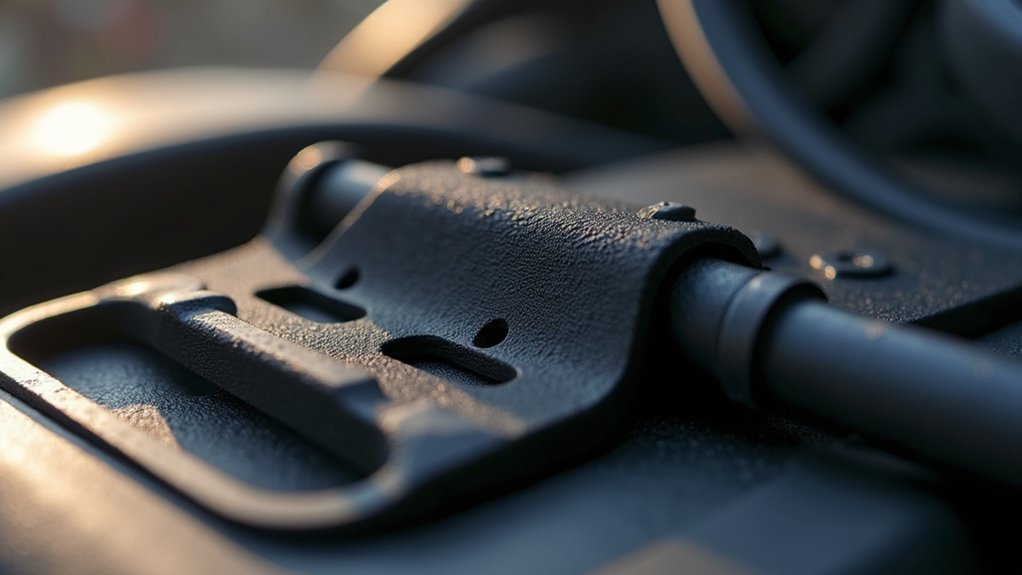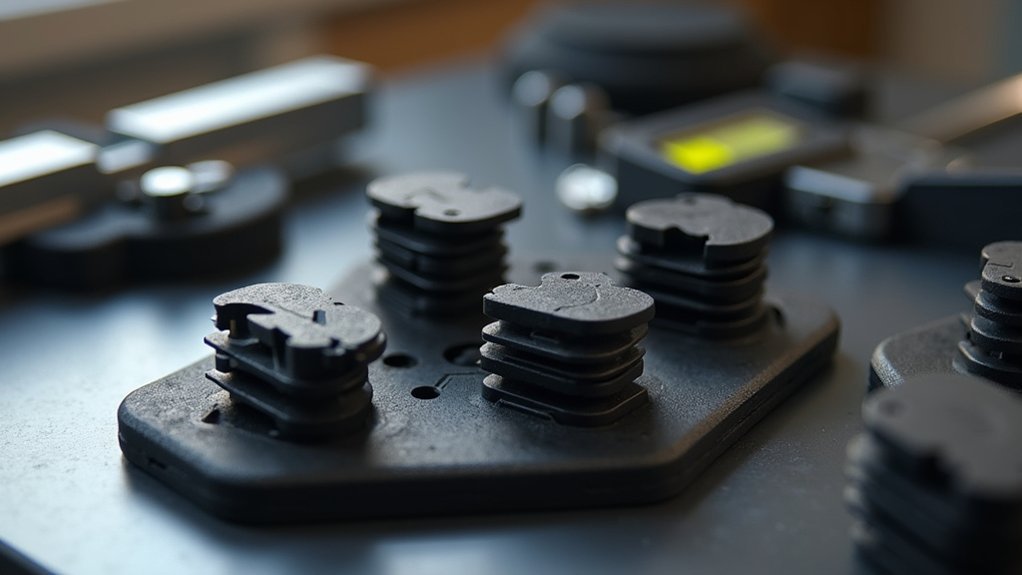You’ll achieve professional-grade automotive sensor mounts by focusing on three critical areas. First, use topology optimization to balance weight reduction with structural integrity—BMW achieved 44% weight reduction while improving stiffness 10x. Second, select materials like ASA or ABS that withstand extreme temperatures from -40°F to 200°F and variable moisture levels. Third, incorporate snap-fit mechanisms and alignment features for intuitive installation in cramped spaces. Master these fundamentals to reveal advanced techniques that guarantee long-term reliability.
Design for Optimal Weight Distribution and Structural Integrity

When designing 3D-printed automotive sensor mounts, you’ll need to balance weight reduction with structural performance to create components that excel under demanding conditions.
Start by incorporating topology optimization techniques to minimize material usage while maintaining strength—BMW’s approach achieved 44% weight reduction with 10x improved stiffness.
Focus on load distribution features that spread stress evenly across your mount’s structure, preventing failure points during dynamic operation.
Use simulation software to analyze weight distribution and optimize your sensor’s center of gravity for enhanced vehicle performance.
When you design and produce these mounts, select materials like Nylon or Carbon-fiber Nylon for superior impact resistance and rigidity.
Verify your automotive sensor mounts include sufficient surface area for secure attachment points, improving stability and preventing vibration-related failures that compromise structural integrity.
Select Materials That Withstand Automotive Environmental Conditions
Material selection directly impacts your sensor mount’s ability to survive harsh automotive environments where temperatures can swing from -40°F to over 200°F, moisture levels fluctuate dramatically, and UV exposure degrades inferior plastics.
Choosing the wrong material for automotive sensor mounts means certain failure when extreme temperatures and UV exposure strike.
For additive manufacturing of custom parts requiring exceptional heat resistance, ASA and ABS stand out as premium choices. These materials excel when printing car parts exposed to extreme temperatures while maintaining structural integrity.
Nylon delivers superior impact resistance for demanding applications, though you’ll need protective treatments due to its moisture sensitivity.
Carbon-fiber Nylon provides the ultimate performance solution, offering lightweight stiffness for stress-heavy installations.
PETG works well for interior applications but avoid it in high-heat zones where softening occurs.
Always evaluate your specific environmental conditions before finalizing material selection.
Incorporate Easy Installation Features and Alignment Systems

Since automotive sensor installations often occur in cramped spaces with limited visibility, you’ll want to design mounts that practically install themselves through intuitive features.
Easy installation starts with snap-fit mechanisms that eliminate the need for additional tools during assembly and disassembly. Your 3D printing design should include integrated alignment features like guide pins or slots that guarantee precise positioning across different vehicle models.
Consider incorporating adjustable brackets with multiple mounting holes to accommodate sensor dimensional variations and diverse vehicle surfaces.
Clear markings on your parts will guide proper sensor orientation during installation. Using flexible materials like TPU in your mounting brackets helps absorb vibrations while maintaining alignment integrity, ultimately extending your sensor setup’s operational lifespan and reliability in demanding automotive environments.
Frequently Asked Questions
What Is the Most Profitable Thing to 3D Print?
You’ll find automotive sensor mounts extremely profitable to 3D print because they’re in high demand, cost $5-50 to produce, command premium pricing for custom applications, and let you quickly iterate designs based on customer feedback.
Is It Illegal to 3D Print a Glock Lower?
You can legally 3D print a Glock lower receiver for personal use in most US states, but you’ll need to check your specific state laws since regulations vary considerably across different jurisdictions.
How to Increase Adhesion in 3D Printing?
You’ll increase adhesion by cleaning your build plate thoroughly, using proper bed temperatures, applying adhesive aids like glue stick, adjusting first layer settings, and adding brims or rafts to your prints.
How to Get Stubborn Supports off 3D Print?
Use a heated chamber or warm water to soften stubborn supports, then carefully pry them off with a craft knife. For ABS prints, you can apply heat guns or chemical solvents like acetone.





Leave a Reply